Information
A propos Al-Sabil
Numéros en texte
intégral
Numéro 16

Préface
Richard KLEIN
Introduction
Amina HARZALLAH et Imen REGAYA
Vers une réhabilitation énergétique de l’architecture moderne: Immeubles d’habitation du quartier de St Exupéry à Tunis.
Rania FARAH JAAFAR, Amina HARZALLAH et Leïla AMMAR
El Menzah I : habiter une modernité située.
Narjes BEN ABDELGHANI, Ghada JALLALI et Alia BEN AYED
16 | 2023
Les configurations visuelles ornementales ferronnières et leur rôle dans la valorisation des ambiances du passé
Mounira DRIDI
Table des matieres
Introduction
1. Présentation du corpus
2. La relation de l’ambiance à l’architecture et à l’ornement
3. Caractéristiques stylistiques et esthétiques de l’ornement ferronnier dans les façades
4. Caractéristiques techniques et patrimoniales de la ferronnerie
Conclusion
Résumé
La ferronnerie, un des composants architectoniques qui structurent le style des façades et participent au plaisir visuel des villes en général et des édifices en particulier, se voit délaissée aux aléas du temps et sans aucun projet de préservation. Sa dégradation et son altération risquent de nous faire perdre un des éléments architectoniques contribuant à l’esthétique des architectures et une importante source de témoignage sur un art et un savoir-faire particulier du patrimoine récent, celui de l’époque coloniale.
Notre contribution s’articule autour de la patrimonialisation de la ferronnerie liée à l’architecture des XIXe et XXe siècles pour sa dimension communicante par ce qu’elle est comme élément architectonique participant d’emblée à l’ambiance esthétique des façades des bâtiments et de tout le paysage urbain de l’ère coloniale, par ce qu’elle exhibe de styles et de source ornementale très variée et par ce qu’elle incarne et dévoile comme techniques d’exécution modernes signe d’un progrès industriel qui a marqué la Tunisie à cette époque. Tous ces éléments confèrent à la ferronnerie des XIXe et XXe siècles une identité exemplaire et incitent à sa patrimonialisation tout comme l’architecture à laquelle elle est liée.
Mots clés
Ferronnerie – identité - ambiance esthétique - architecture coloniale - patrimoine.
Abstract
Ironwork, one of the architectural components that structure the style of facades and contribute to the visual pleasure of cities in general and buildings in particular, has been neglected by the vagaries of time and without any preservation project. Its degradation and alteration risk causing us to lose one of the architectonic elements that contribute to the aesthetics of architectures and an important source of testimony to a particular art and know-how of recent heritage, that of the colonial era.
Our contribution revolves around the heritage value of ironwork linked to the architecture of the 19th and 20th centuries for its communicating dimension by what it is as an architectonic element participating from the outset in the aesthetic atmosphere of the facades of buildings and all the urban landscape of the colonial era, by what it exhibits styles and so varied ornamental source and by what it embodies and reveals as modern execution techniques sign of an industrial progress which marked Tunisia at that time. All these elements give ironwork from the 19th and 20th centuries an exemplary identity and encourage its heritage status, just like the architecture to which it is linked.
Keywords
ironwork - identity- aesthetic atmosphere - colonial architecture - heritage.
الملخّص
تمثل المشغولات الحديدية أحد العناصر المعمارية التي تبني أسلوب الواجهات وتساهم في المتعة البصرية للمدن بشكل عام وللمباني بشكل خاص. إلا أننا نلاحظ تدهورها في الواجهات المعمارية التي تعود إلى فترة الاستعمار بسبب فعل الوقت وبدون أي برنامج أو مشروع لحمايتا من التلف. نحاول من خلال هذا المقال تثمين هذا الإرث من الأعمال الحديدية المرتبطة بعمارة القرنين التاسع عشر والعشرين لأبعادها التواصلية من خلال ما هي عليه كعنصر معماري يشارك منذ البداية في الجو الجمالي لواجهات المباني وكامل المنظر الحضري للمنطقة في العصر الاستعماري، كذلك من خلال ما تعرضه من أنماط وتنوّع زخرفي ثري للغاية وما تجسده وتكشف عنه من تقنيات تنفيذ حديثة، علامة على التقدم الصناعي الذي عرفته البلاد التونسية في ذلك الوقت. كل هذه العناصر تعطي الأعمال الحديدية التي تعود إلى القرنين التاسع عشر والعشرين هوية نموذجية وتثمن مكانتها التراثية، تمامًا مثل الهندسة المعمارية التي ترتبط بها.
الكلمات المفاتيح
الزخرفة الحديدية – الهوية - الجو الجمالي - العمارة الاستعمارية – التراث
Pour citer cet article
DRIDI Mounira, «Les configurations visuelles ornementales ferronnières et leur rôle dans la valorisation des ambiances du passé», Al-Sabîl : Revue d’Histoire,
d’Archéologie et d’Architecture Maghrébines [En ligne], n°16, Année 2023.
URL : https://al-sabil.tn/?p=2947
Texte integral
Le paysage urbain colonial, un patrimoine récent, s’ajoute à celui de la Médina traditionnelle et le tout forme notre patrimoine local national. Chacun des deux paysages nous impressionne, crée en nous une sensation unique et prégnante. Chaque expérience nous fait pénétrer dans une atmosphère singulière et totalement différente de l’autre. Les éléments constitutifs de chacun des deux paysages contribuent de façon particulière à la création de telles ambiances.
Ce sont les configurations visuelles ornementales ferronnières qui nous ont marquées le plus fortement dans notre ressenti d’ambiance propre à la ville coloniale. Tellement nombreuses et variées qu’elles ont créé une variété visuelle très riche et ont procuré aux façades une touche esthétique distinctive. Elles participent, pleinement, à l’image des bâtiments, des rues et de toute la ville. Leur abondance en fait des éléments familiers du paysage urbain colonial. Cependant, de multiples balcons dénotent d’une grande dégradation et altération de leurs décors ferronniers qui risquent d’en perdre des traces. D’autres ont été supprimés et remplacés par du béton. L’indifférence et l’insensibilité envers un tel legs entrainera la perte d’un élément architectonique qui participe d’emblée dans notre ressenti d’ambiance particulière lié à la ville européenne réalisée à l’époque coloniale.
Cet article se propose de mettre en exergue les différentes particularités de l’ornement ferronnier, présent dans le décor des façades architecturales de la ville coloniale, lui octroyant un rôle important dans la valorisation des ambiances du passé.
Afin d’atteindre notre objectif, différentes approches ont été retenues : celle des styles et de l’esthétique, celles des techniques et des matériaux, celle des caractéristiques patrimoniales de la ferronnerie et celle des auteurs de ces ouvrages. Avant de se lancer dans toutes ces approches, une autre approche est également convoquée et qui relève de la relation entre l’ambiance, l’architecture et l’ornement : de quel ordre est-elle ?
Nous avons choisi de travailler sur une des rues de la ville de Tunis qui témoigne de la présence de tous les styles esthétiques et ornementaux inhérents à l’architecture de la ville pendant la période coloniale. Il s’agit de la rue Charles de Gaulle, jadis rue d’Italie, qui se présente comme « un échantillon d’une ville au style européen » par le plan en damier, par la nature des édifices qui y sont élevés et par les belles et diverses ferronneries constatées dans les façades. Nous nous intéresserons tout particulièrement aux ornements ferronniers des balcons qui garnissaient les façades et protégeaient, certainement, les ouvertures.
1. Présentation du corpus
1.1. Bref historique
La rue Charles de Gaulle est l’une des rues les plus anciennes de la nouvelle ville européenne. Baptisée rue d’Italie, ce qui ne signifiait pas qu’elle était peuplée, uniquement, d’italiens, ni que ces derniers en avaient conçu et réalisé l’architecture. Il s’agit d’un hommage du colonisateur à ses prédécesseurs italiens venus en grand nombre s’installer en Tunisie depuis des décennies bien avant le Protectorat1. Cette rue aurait été nommée rue Charles de Gaulle en hommage à l’auteur de l’appel du 18 juin 1940.
1.2. Caractéristiques urbaines
L’actuelle rue Charles de Gaulle formait, avec les rues qui la recoupaient, un noyau de viabilité au sud de l’avenue de France depuis 18812. Son organisation présentait un « échantillon de la ville européenne » qui adoptait le plan en damier. C’est une rue assez longue, traversée par six (6) rues : d’Hannon, d’Allemagne, jadis rue des Belges, d’Espagne, d’Angleterre, de Russie et du Maroc (fig. 1). L’importance donnée à cette artère depuis 1881, est encore amplifiée en 1891-1892, par l’édification de deux constructions colossales : la première est administrative avec l’Hôtel des postes et télégraphes de Tunis et la deuxième est commerciale avec le Marché Central de Tunis.
Cette rue ne s’est pas limitée aux fonctions d’habitation, de commerce et d’administration mais acquiert également une fonction éducative avec l’édification d’une école de garçon et une fonction religieuse avec l’Eglise réformée française, et par là même, elle participe pleinement à la vie sociale des européens.
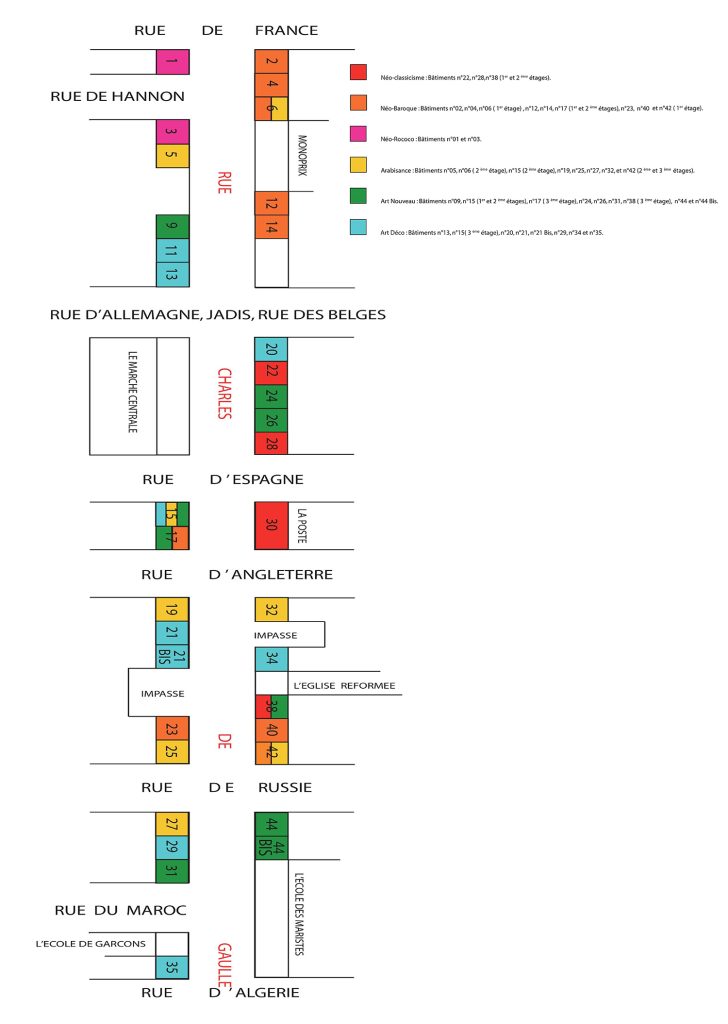
Source : Dessin graphique de l’auteure.
2. La relation de l’ambiance à l’architecture et à l’ornement
Dans cette partie, nous tenterons d’aborder la notion d’ambiance et sa relation à l’architecture et à l’ornement en nous référant aux différentes définitions apportées par les diverses disciplines.
Le terme « Ambiance », à la fois familier et vague, représente aujourd’hui, et depuis quelques décennies un domaine de recherche pluridisciplinaire en plein essor international, en particulier dans le monde de la recherche architecturale et urbaine.
Différentes définitions lui sont attribuées dans la mesure où il est « un champ de recherche ouvert et poreux qui s’enrichit des nombreux travaux de modélisation et de caractérisation physique du sensible, des recherches en esthétique, en sciences cognitives (en particulier l’approche écologique de la perception), ou encore des apports de la sociologie et de l’anthropologie des espaces habités »3 L’ambiance relève du rapport sensible de l’homme à l’espace , qu’il soit ordinaire ou plus scénographié ; c’est une expérience sensible que l’on fait d’un lieu donné à un moment donné, elle est donc liée à nos sensations et émotions synesthésiques autant que cénesthésiques 4.
Le Corbusier affirmait : « La construction, c’est fait pour tenir, l’architecture pour émouvoir »5. Et si « l’ultime but de l’art est de nous conduire dialectiquement de satisfaction en satisfaction par-delà l’admiration, jusqu’à la sereine délectation »6, alors, l’architecture, considérée comme le premier des arts, est disposée à produire, à générer une émotion.
En se référant à l’histoire de l’architecture, on s’aperçoit que, depuis l’antiquité jusqu’au début du XXe siècle, l’ornement a toujours constitué un élément essentiel dans le processus de création architecturale. Et si l’architecture est considérée comme étant le premier des arts, c’est essentiellement en raison de son rapport à l’ornement. Appliqué sous ses différentes formes sur les façades architecturales, l’ornement est fait pour être remarqué comme un élément visuel qui sollicite l’attention et provoque une émotion.
Or, l’étude ou la science des émotions relève de l’esthétique. Le terme provient du grec aisthēsis qui signifie : « la perception par les sens ». Au XVIIIe siècle, le terme s’est développé pour signifier la science du sensible. Au XIXe siècle, « l’esthétique » devient une discipline de la philosophie qui étudie les perceptions produites par la nature et l’art (et tout particulièrement l’art) se rapportant aux émotions qu’elles provoquent.
En tenant compte de ce qui précède, nous pouvons dire que l’objet architectural, en tant qu’œuvre d’art, où l’ornement est le premier élément visuel transmis, porte en lui et transmet une esthétique sensibilisante. En ce sens, elle est génératrice d’émotions, qui sont la « traduction subjective de l’ambiance d’un lieu dans ses aspects aussi bien matériels que symboliques » 7.
Selon Gernot Böhme, l’ambiance en architecture est « en quelque sorte la qualité esthétique d’une scène ou d’un paysage »8. En l’occurrence, interroger le rôle de l’ornement ferronnier dans la valorisation des ambiances architecturales du passé veut dire chercher ses qualités esthétiques ; ceci nous amène à procéder, dans ce qui suivra, à une approche esthétique pour étudier les spécimens sélectionnés.
3. Caractéristiques stylistiques et esthétiques de l’ornement ferronnier dans les façades
Notre objectif dans ce que suit est de déceler la valeur esthétique des configurations visuelles ornementales en matière de fer et de fonte garnissant les façades architecturales de l’époque coloniale. Pour cela nous avons procédé à une classification stylistique de l’ensemble des bâtiments de la rue Charles de Gaulle. De chaque style répertorié, nous avons choisi un spécimen afin d’examiner ses caractéristiques stylistiques (caractères généraux et traits distinctifs de l’ornementation, nature des ornements, etc.) et ses normes esthétiques (harmonie, rythme, symétrie, contraste, notion du centre, composition, etc.). Le développement industriel a mis au service des ferronniers de nouvelles techniques et de nouveaux moyens leur facilitant la tâche et permettant plus de créativité et de variété ornementale. Nous avons alors trouvé indispensable de mentionner la technique d’exécution pour chaque exemple étudié étant donné qu’elle influe sur la configuration des objets et des ornements.
L’étude de l’architecture de la ville coloniale de Tunis nous livre un ensemble de styles variés dont le principe d’esthétique a évolué d’une exubérance ornementale exaltant l’ornement à un rejet de tout ce qui est décoratif pour que la beauté d’un monument soit donnée par ses formes simples, épurées et sa fonctionnalité. Dans les premiers temps du protectorat c’est l’Eclectisme ou le style du « Vainqueur »9, qui s’est manifesté dans l’architecture de la ville. C’est un style qui est reconnaissable à un emprunt à plusieurs styles à la fois dans les modèles décoratifs et les éléments architectoniques tels que : néo-renaissance, néo-gothique, néo-roman, néoclassicisme, baroque, rococo. À travers notre étude de la ferronnerie, élément architectonique appliqué sur les façades des bâtiments de style éclectique construits dans les premiers temps du Protectorat de 1881 à 1900, nous avons pu distinguer, non seulement, des compositions éclectiques, mais aussi d’autres nettement néoclassiques, baroque et rococo. Depuis le début du XXe siècle, les styles modernistes envahissent les nouvelles architectures de la ville pour noter des ornements ferronniers de styles : Art nouveau, Arabisance et Art déco. De ce fait, dans ce qui va suivre nous procéderons à une étude de six spécimens de ferronnerie relatant l’ensemble des six styles esthétiques que nous venons de présenter.
3.1. Ornement ferronnier de style néoclassique
L’immeuble étudié est sis au n°22 de la rue Charles de Gaulle : les compositions des balcons des 1er et 2ème étages affichent une ornementation en fonte fidèle au style néo-classique10 (fig.2 et 3).
Les motifs ornementaux se composent d’une couronne de laurier accompagnée d’un ruban en forme de papillon, le laurier sous forme de tige comprenant quelques fruits, une guirlande d’épis, une feuille d’acanthe, une tulipe et des roses. Les formes circulaires employées apportent un aspect de dynamisme et de mouvement à la composition qui suit un axe de symétrie verticale.

Source : Photo de l’auteure.
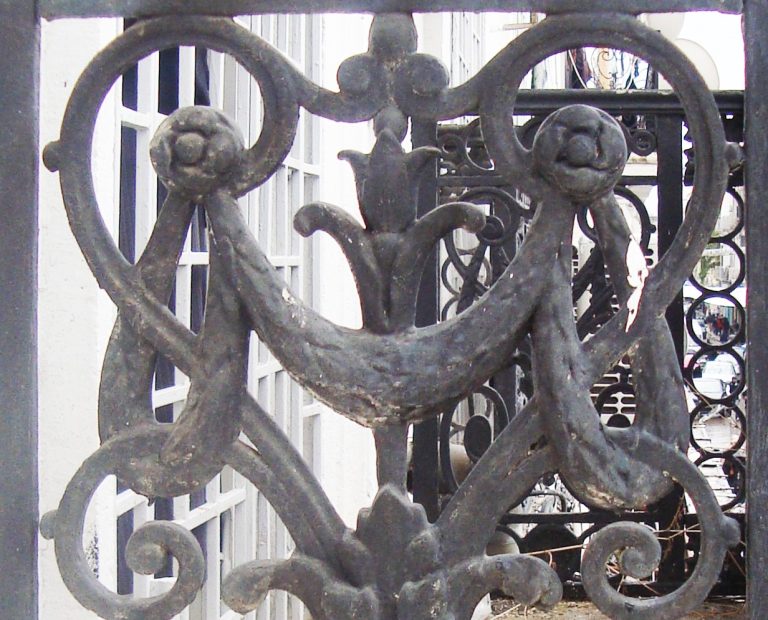
Source : Photo de l’auteure.
3.2. Ornement ferronnier de style néobaroque
L’immeuble étudié, édifié avant 189311, est sis au 4 rue Charles de Gaulle. Les compositions de l’ensemble des balcons garnissant la façade affichent une ornementation en fonte fidèle au style néobaroque qui manifeste, principalement, un goût pour la botanique et pour la représentation figurative (fig. 4 et 5). Occupant le centre de la composition, une figure humaine est représentée avec tous les détails du visage, et entourée d'une diversité d'éléments botaniques, citons : la feuille d'acanthe en rinceau, la tulipe, une ou deux rangées de la fleur de lys, une variété de fleurs, en plus du feuillage stylisé représenté sous la forme de petites volutes.

Source : Photo de l’auteure.
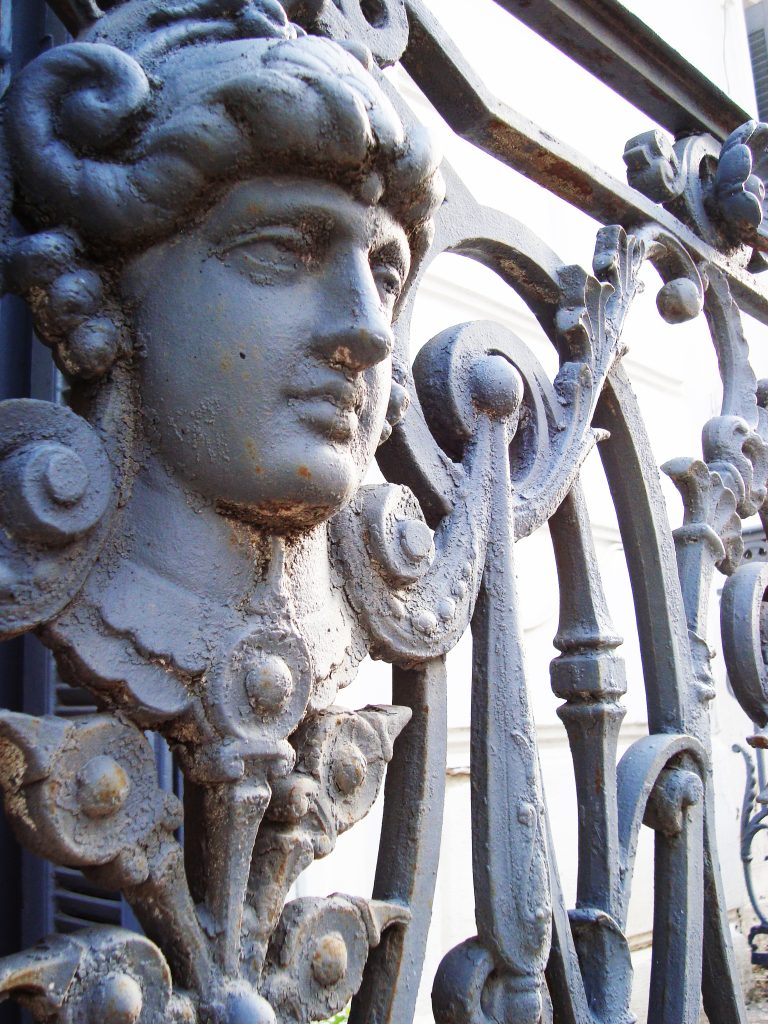
Source : Photo de l’auteure.
3.3. Ornement ferronnier de style rococo
L’immeuble en question est sis au n°3 de la rue Charles de Gaulle. Toutes les compositions sont conçues dans le même style ornemental : le rococo12 (fig. 6). Ce dernier se distingue des styles précédents par un nouveau répertoire iconographique mettant à nu un goût pour les rocailles et les rochers, ce qui justifie la prédilection de ce style pour la représentation asymétrique. C’est ainsi que les compositions des côtés droit et gauche des balcons de la façade donnant vue sur la rue en question suivent le principe esthétique d’asymétrie. Ces compositions comportent certains éléments ornementaux spécifiques au rococo, nous citons : l’arabesque, les cannelures, le cartouche, les formes arrondies et contournées, les volutes en forme de C et les formes végétales et sinueuses. Tous ces éléments expriment le dynamisme et le mouvement dans ces compositions en fonte, avec un contraste remarquable entre la droite et la courbe.
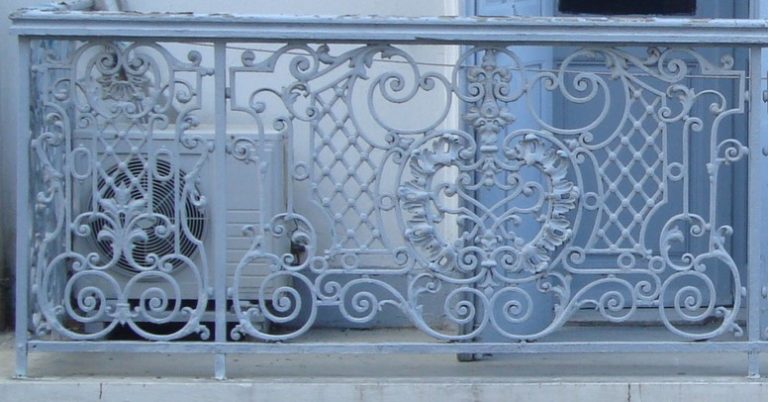
Source : Photo de l’auteure.
3.4. Ornement ferronnier de style Art nouveau
L’immeuble que nous avons choisi comme exemple d’Art nouveau, est sis au 9 rue Charles de Gaulle. Il se compose d’un rez-de-chaussée et de trois étages. Les compositions en ferronnerie des balcons varient d’un étage à un autre et se caractérisent tous par une exubérance des lignes sinueuses, courbes et ondulées faisant preuve d’une grande liberté créative, très recherchée au XIXe siècle et enfin atteinte avec le style Art nouveau. La technique d’exécution est le fer forgé employant le fer plat comme matériau et procédant par des rivets et de la soudure autogène pour l’assemblage des fragments de la composition (fig. 7).
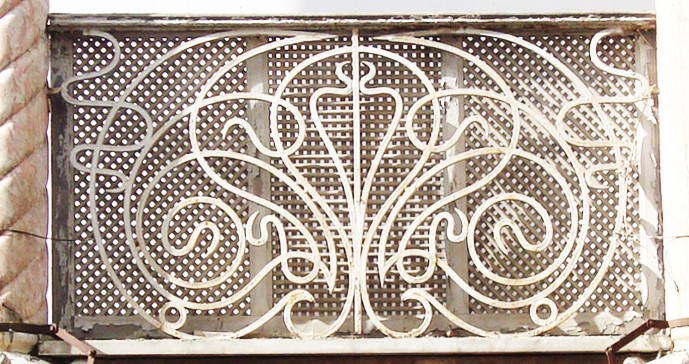
3.5. Ornement ferronnier de style Arabisance
Nous avons choisi comme référence à ce style, l’immeuble sis au n°5, de la rue Charles de Gaulle, composé d’un rez-de-chaussée et de trois étages13 (fig.8.). Tous les balcons et balconnets de la façade sont garnis de la même ferronnerie structurée sur la répétition d’un même motif procurant un rythme régulier dans la composition. Le motif d’arc outrepassé rappelle l’architecture arabe (fig. 9). La technique de réalisation est celle du fer forgé employant le fer plat comme matériau et procédant par des rivets pour l’assemblage des éléments de la composition.

Source : Photo de l’auteure.
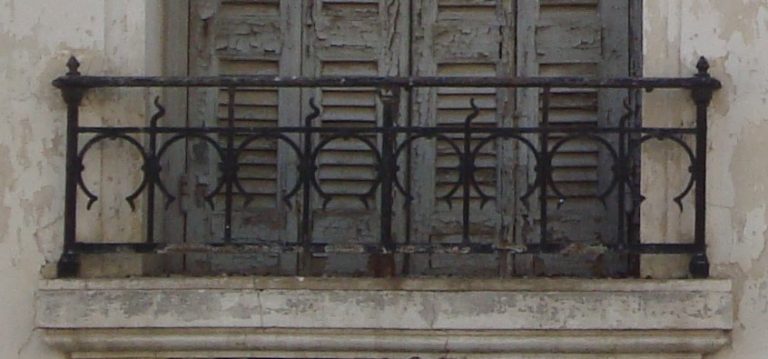
Source : Photo de l’auteure.
3.6. Ornement ferronnier de style Art déco
L’immeuble choisi comme exemple de style Art déco est sis au 13 rue Charles de Gaulle. Il se compose d’un rez-de-chaussée et de trois étages. Les compositions de ferronnerie du deuxième étage traitent le thème de la fleur stylisée, reine de la période Art déco (fig. 10). Les compositions du troisième étage laissent paraître une autre configuration de la fleur stylisée, différente de celle notée au deuxième étage, ainsi que des formes géométriques. Le recours aux formes géométriques atteste bien de l’influence du cubisme dans le style art déco (fig. 11).
L’ensemble de ces éléments forme un attrait majeur de l’ornementation art déco. La technique de réalisation est indubitablement celle du fer forgé procédant par la soudure et les rivets industrialisés pour l’assemblage des éléments de la composition.

Source : Photo de l’auteure.

Source : Photo de l’auteure.